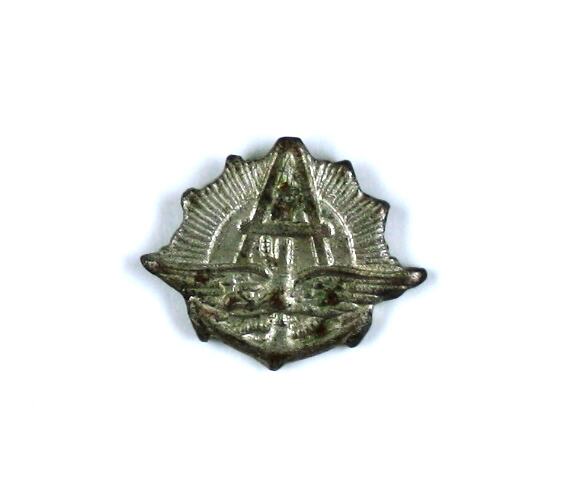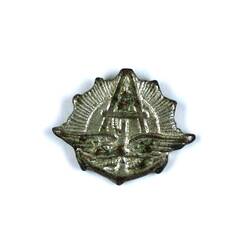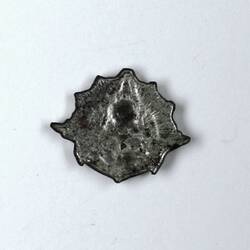Summary
Alternative Name(s): Badge, Brooch
A small silver-coloured pin or badge, inscribed 'A', with sunburst behind and wings and anchor below. Crudely formed - likely to have been a fund-raising badge, the 'A' standing for 'Anzac' and the symbols suggesting the army, navy and air force.
From a collection of material associated with the World War I service of Gunner James Clive Talbot.
James Clive Talbot was a 20-year-old grazier and wool classer from 'Yeo Vale', Birregurra, Victoria, when he enlisted to fight in World War I on 2 April 1915 (service #1350). As part of the 24th Battalion he served in Gallipoli and on the Western Front. He was killed in action aged 22, on 22 September 1917 in Belgium (during in the Third Battle of Ypres). His father (perhaps both his parents) appears to have taken the unusual step of visiting his grave - out of the reach of many bereaved in Australia. They also placed a blackwood pulpit at the Birregurra Church of England, in memory of their son, who they knew as Clive. It is inscribed '...in loving memory of our beloved son and brother, James Clive Talbot, killed in action September 22nd, 1917, aged 22 years. He has fought a good fight, he has finished his work; he has kept the faith.'
Physical Description
Small pin with 'A' at centre, imposed over sunburst, with wings and anchor below. The back of the badge has an abrased section suggesting that an original pin has been cut off. It now has no means of fastening.
Significance
The James Talbot mourning collection is of particular significance since it documents a set of personal effects from a son lost at war, including a tiny photograph and engraved medal presented to his bereaved parents, and his colour patch, buttons and badges. Importantly, it also includes a large certificate from Ypres Reservoir British Cemetery, Belgium, including cemetery images and Talbot's details pasted into a box at the centre. (Further research may link this to his father's visit to the cemetery.) It provides an important insight into the ways Australians memorialized the distant graves of their loved ones (discussed by Bart Ziino in A Distant Grief, and others).
More Information
-
Collecting Areas
-
Acquisition Information
Purchase
-
Previous Owner
Private James C. Talbot - Australian Imperial Force (AIF), circa 1915-1917
-
Organisation Symbolised
-
Inscriptions
On front: 'A'.
-
Classification
-
Category
-
Discipline
-
Type of item
-
Overall Dimensions
18 mm (Width), 2 mm (Depth), 15 mm (Height)
-
References
Bart Ziino, 2007. A Distant Grief: Australians, War Graves and the Great War. University of Western Australia Press. Commonwealth War Graves Commission web site [Link 1] accessed 3/1/2014.
-
Keywords
World War I, 1914-1918, Certificates, Service, Memorials, Death & Mourning, World War I Fundraising, Battle of the Somme (Somme Offensive), 1916




